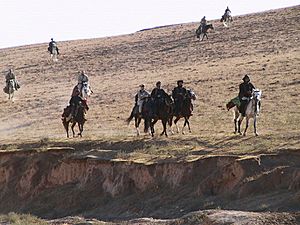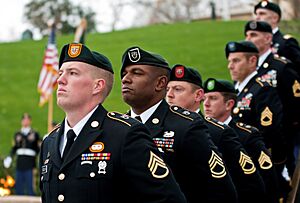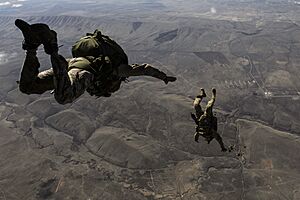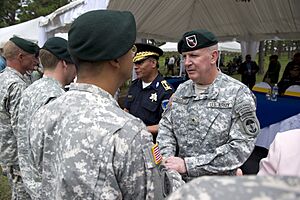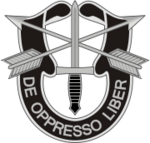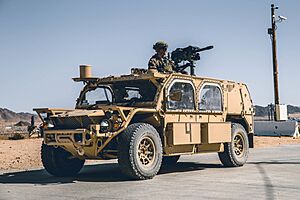United States Army Special Forces facts for kids
The United States Army Special Forces (SF), often called the "Green Berets" because of their special green hats, are a highly trained part of the United States Army. They are known for their unique skills and missions. Unlike most Army groups, you can only join the Special Forces after serving in another Army branch first.
The Green Berets have five main jobs:
- Unconventional Warfare: Helping local groups fight against an enemy.
- Foreign Internal Defense: Training and helping friendly foreign armies.
- Direct Action: Quick, small attacks to capture or destroy targets.
- Counterterrorism: Stopping terrorist groups.
- Special Reconnaissance: Secretly gathering information about an enemy.
They are experts in languages and cultures. Green Berets learn a foreign language and study the politics, economy, and culture of the areas where they work. This helps them work well with troops from other countries. They also do other important jobs like rescuing hostages, helping with disasters, and finding dangerous people. Many of their secret methods are not shared with the public.
The Special Forces have a long and close history with the Central Intelligence Agency (CIA). This connection goes back to groups like the OSS during World War II. They have worked together on many missions, from the Vietnam War to the War in Afghanistan.
Quick facts for kids U.S. Army Special Forces |
|
|---|---|
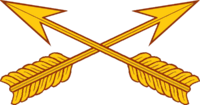
Special Forces branch insignia
|
|
| Active |
|
| Country | |
| Branch | |
| Type | Special operations force |
| Role |
|
| Size | 7 special forces groups |
| Part of | 1st Special Forces Command United States Army Special Operations Command United States Special Operations Command |
| Headquarters | Fort Liberty, North Carolina |
| Nickname(s) | Green Berets, Quiet Professionals, Commandos, Soldier-Diplomats, Snake Eaters |
| Motto(s) | De Oppresso Liber |
| Color of Beret | Rifle green |
| March | "The Ballad of the Green Berets" |
| Engagements |
|
Contents
Their Special Missions
The main job of the Army Special Forces is to train and lead hidden groups, like guerrilla fighters, in countries that are taken over by an enemy. For example, the 10th Special Forces Group was first sent to train these groups in case of an invasion in Europe.
Later, they also started helping countries defend against hostile guerrillas. This mission is called Foreign Internal Defense (FID). They work with local forces to stop guerrilla activities, from giving advice to leading battles.
Special Forces soldiers are skilled in advanced military tactics. They also learn the languages and cultures of specific parts of the world. While they are famous for their unconventional warfare skills, they also do other missions. These include quick raids, helping keep peace, stopping the spread of dangerous weapons, advising on drug control, and other important tasks.
These elite teams work very closely together. They depend on each other, especially during long missions in isolated places. Many Special Forces leaders spend their whole careers in the Special Forces. They move between different roles, like leading teams, working in headquarters, or teaching at the John F. Kennedy Special Warfare Center and School.
A Look Back: Their History
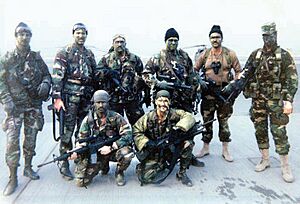
The idea of special forces in America goes way back to the 17th and 18th centuries. A man named Benjamin Church created the first "Ranger" force in 1676. He learned to fight like Native American tribes, and his methods are seen as early examples of unconventional warfare.
The modern Special Forces trace their roots to special units from World War II. These include the United States Army Rangers, Alamo Scouts, and the Office of Strategic Services (OSS). Many Army members who worked in the OSS later helped create the Special Forces.
During the Korean War, soldiers like Colonel Wendell Fertig and Lieutenant Colonel Russell W. Volckmann used their experiences to develop the ideas for unconventional warfare. These ideas became the foundation of the Special Forces.
In 1952, the 10th Special Forces Group (Airborne) was formed under Colonel Aaron Bank. This happened soon after the Psychological Warfare School was created, which is now the John F. Kennedy Special Warfare Center and School. The 10th SFG was later split, and part of it became the 7th Special Forces Group.
Since 1952, Special Forces soldiers have served in many conflicts and countries around the world. These include Vietnam, El Salvador, Panama, Gulf War, Afghanistan, and Iraq. The Special Forces officially became a separate branch of the U.S. Army on April 9, 1987.
How Green Beret Teams Are Organized
Special Forces Groups
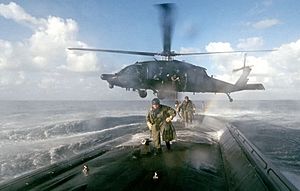
The Special Forces are divided into five active-duty groups and two Army National Guard groups. Each group focuses on a specific region of the world. This means the soldiers in that group get special language and cultural training for countries in their assigned area.
Because of the high demand for Special Forces soldiers, especially during the War on Terror, all groups have been sent to different areas, like Iraq and Afghanistan. Many soldiers have spent a lot of their careers overseas.
Until 2014, each Special Forces group had three battalions. Now, each active-duty group has four battalions.
A Special Forces group is usually assigned to a large military command or a specific area of operations. Within a group, there are different types of teams:
- SF Operational Detachment C (SFODC): This is the headquarters for a Special Forces battalion. It commands and controls smaller teams.
- SF Operational Detachment B (SFODB): This team supports the smaller "A-Teams" and helps manage their missions.
- SF Operational Detachment A (SFODA): These are the main 12-soldier teams that carry out missions.
Battalion Headquarters – SFODC (C-Team)
The SFODC, or "C-Team," is the main headquarters for a Special Forces battalion. It handles operations, training, communications, and supplies for its three companies. A lieutenant colonel leads the battalion and the C-Team. The Command Sergeant Major is the most senior enlisted soldier. The C-Team also has 20-30 other Special Forces soldiers who work in key areas like intelligence and medical support. A Special Forces battalion usually has four companies: "A," "B," "C," and a Headquarters/Support company.
Company Headquarters – SFODB (B-Team)
The ODB, or "B-Team," is the headquarters for a Special Forces company. It usually has 11-13 soldiers. While the A-teams do the direct missions, the B-Team's job is to support them both at base and in the field.
The ODB is led by a major, who is the company commander. A captain helps him as the executive officer. A chief warrant officer also helps with planning and training. The company commander is also supported by a senior non-commissioned officer, usually a sergeant major. Other important roles include an operations sergeant, a medical sergeant, and communications sergeants.
The B-Team also has support roles like a supply sergeant, who helps get supplies for the company. They also have specialists for chemical, biological, radiological, and nuclear defense. Other experts, like IT personnel and intelligence soldiers, can also be part of the B-Team.
Basic Element – SFODA (A-Team)
A Special Forces company usually has six Operational Detachments-A (ODA or "A-Teams"). Each ODA is skilled in a specific way to get into an area or a particular type of mission. These skills might include military free fall (HALO) or combat diving.
Each ODA team has a unique number. Since 2007, these numbers have four digits. The first digit tells you the group (like 1 for 1st SFG). The second digit is for the battalion (1-4). The third digit is for the company (1-3). The fourth digit is for the specific team within that company (1-6). For example, ODA 1234 means it's the fourth ODA in Charlie Company, 2nd Battalion, 1st Special Forces Group.
An ODA has 12 soldiers. Each soldier has a specific job, but all members are trained in multiple skills. The ODA is led by a captain, who is the Detachment Commander. A warrant officer is their second in command. The team also includes:
- One Operations Sergeant (the "Team Sergeant"), usually a Master Sergeant.
- One Assistant Operations and Intelligence Sergeant, usually a Sergeant First Class.
- Two Weapons Sergeants.
- Two Engineer Sergeants.
- Two Medical Sergeants.
- Two Communications Sergeants.
This setup allows for smaller 6-person "split teams" to operate if needed. It also ensures that there are always backups for each role and that senior soldiers can mentor junior ones.
| Beret Flash | Group |
|---|---|
| 1st Special Forces Group – Headquartered at Joint Base Lewis–McChord, Washington along with its 2nd, 3rd, and 4th Battalions, its 1st Battalion is forward deployed at Torii Station, Okinawa. The 1st SFG(A) is oriented towards the Pacific region, and is often tasked by PACOM. | |
| 3rd Special Forces Group – Headquartered at Fort Liberty, North Carolina. The 3rd SFG(A) is theoretically oriented towards all of Sub-Saharan Africa with the exception of the Eastern Horn of Africa, i.e. United States Africa Command (AFRICOM). | |
| 5th Special Forces Group – Headquartered at Fort Campbell, Kentucky. The 5th SFG(A) is oriented towards the Middle East, Persian Gulf, Central Asia and the Horn of Africa (HOA), and is frequently tasked by CENTCOM. | |
| 7th Special Forces Group – Headquartered at Eglin Air Force Base, Florida. The 7th SFG(A) is oriented towards the western hemisphere: the land mass of Latin America south of Mexico, the waters adjacent to Central America and South America, the Caribbean Sea—with its 13 island nations, European and U.S. territories—the Gulf of Mexico, and a portion of the Atlantic Ocean (i.e. the USSOUTHCOM AOR and a little more). Although not aligned, the 7SFG(A) has also supported USNORTHCOM activities within the western hemisphere. | |
| 10th Special Forces Group – Headquartered at Fort Carson, Colorado along with its 2nd, 3rd and newly added 4th Battalions, its 1st Battalion is forward deployed in the Panzer Kaserne (Panzer Barracks) in Böblingen near Stuttgart, Germany. The 10th SFG(A) is theoretically oriented towards Europe, mainly Central and Eastern Europe, the Balkans, Turkey, Israel, Lebanon, and Northern Africa, i.e. EUCOM. | |
| 19th Special Forces Group – One of two National Guard Special Forces Groups. Headquartered in Draper, Utah, with companies in Washington, West Virginia, Ohio, Rhode Island, Colorado, California, and Texas, the 19th SFG(A) is oriented towards Southwest Asia (shared with 5th SFG(A)), Europe (shared with 10th SFG(A)), as well as Southeast Asia (shared with 1st SFG(A)). | |
| 20th Special Forces Group – One of two National Guard Special Forces Groups. Headquartered in Birmingham, Alabama, with battalions in Alabama (1st Battalion), Mississippi (2nd Battalion), and Florida (3rd Battalion), with assigned Companies and Detachments in North Carolina; Chicago, Illinois; Louisville, Kentucky; Western Massachusetts; and Baltimore, Maryland. The 20th SFG(A) has an area of responsibility (AOR) covering 32 countries, including Latin America south of Mexico, the waters, territories, and nations in the Caribbean Sea, the Gulf of Mexico, and the southwestern Atlantic Ocean. Orientation towards the region is shared with 7th SFG(A). | |
| Inactive Groups | |
| 6th Special Forces Group – Active from 1963 to 1971. Based at Fort Bragg, North Carolina (renamed Fort Liberty in 2023). Assigned to Southwest Asia (Iraq, Iran, etc.) and Southeast Asia. Many of the 103 original Son tay raider volunteers were from 6SFGA. | |
| 8th Special Forces Group – Active from 1963 to 1972. Responsible for training armies of Latin America in counterinsurgency tactics. | |
| 11th Special Forces Group (U.S. Army Reserve) – Active from 1961 to 1994. | |
| 12th Special Forces Group (U.S. Army Reserve) – Active from 1961 to 1994. |
How to Qualify
To join the Special Forces, current service members must meet certain requirements:
- Be between 20 and 36 years old.
- Be a U.S. citizen.
- Have a high school diploma.
- Score well on the ASVAB test (a military aptitude test).
- Be qualified for Airborne School (where you learn to parachute).
- Pass a physical fitness test and meet height and weight standards.
- Be of a certain rank (Private First Class to Staff Sergeant).
- Have enough time left in their military service after training.
- Be able to get a secret security clearance.
For officers, the requirements are slightly different:
- Be a first lieutenant or captain.
- Score well on a foreign language aptitude test.
- Be able to get a top-secret security clearance.
Support staff who work with Special Forces units but are not Green Berets themselves are not "Special Forces qualified." They have not completed the main Special Forces training course. However, they can earn a special identifier after completing specific training and serving with a Special Forces unit for 24 months.
Selection and Training
The training to become a Special Forces soldier is very tough and continuous throughout their career. The first main training program is called the Special Forces Qualification Course, or "Q Course." It has four phases. The length of the Q Course varies, usually between 55 and 95 weeks. It depends on the soldier's main job and the foreign language they need to learn.
After finishing the Q Course, Special Forces soldiers can take many advanced courses. These include:
- The Military Free Fall Parachutist Course (for advanced skydiving).
- The Combat Diver Qualification Course (for underwater operations).
- The Special Operations Combat Medic Course (for advanced medical skills).
- The Special Forces Sniper Course.
Women in the Green Berets
In 1981, Captain Kathleen Wilder became the first woman to qualify for the Green Berets. After some issues, it was confirmed she had met all requirements. She was later allowed to wear the Special Forces Tab when it was created in 1983. She served for 28 years, retiring as a lieutenant colonel. In July 2020, the first woman to complete the Army Special Forces Qualification Course officially graduated and joined a Green Beret team.
Special Forces Job Descriptions
Each soldier in the Special Forces has a specific job, called a Military Occupational Specialty (MOS):
- 18A – Special Forces Officer (leads teams)
- 180A – Special Forces Warrant Officer (assists commanders)
- 18B – Special Forces Weapons Sergeant (expert in weapons)
- 18C – Special Forces Engineer Sergeant (expert in demolitions and construction)
- 18D – Special Forces Medical Sergeant (expert in combat medicine)
- 18E – Special Forces Communications Sergeant (expert in communications)
- 18F – Special Forces Intelligence Sergeant (gathers and analyzes information)
- 18X – Special Forces Candidate (someone trying to join)
- 18Z – Special Forces Operations Sergeant (senior enlisted leader)
Uniforms and Badges
The Green Beret Hat
U.S. Army Special Forces started wearing the green beret unofficially in 1954. They wanted a hat that would make them stand out. They chose the rifle green color, similar to the berets worn by British Commandos since 1942.
At first, the Army banned the green beret in 1956. But Special Forces members kept wearing it secretly. This changed on September 25, 1961, when President John F. Kennedy officially allowed the green beret to be worn only by the U.S. Special Forces.
President Kennedy believed that because Special Forces had a special mission, they should have something unique to identify them. In 1962, he called the green beret "a symbol of excellence, a badge of courage, a mark of distinction in the fight for freedom."
Kennedy's support created a strong connection with the Special Forces. At his funeral, a Special Forces sergeant placed his green beret on the coffin. This tradition shows the lasting bond between the Special Forces and President Kennedy.
Special Unit Badge
This silver metal badge is about 1 and 1/8 inches tall. It shows two silver arrows crossed, with a silver dagger on top. Below them is a black scroll with the Latin words "DE OPPRESSO LIBER" in silver letters. This motto means "From Oppression We Will Liberate Them."
The badge combines symbols from the First Special Service Force of World War II, like the crossed arrows and a special fighting knife. The badge was approved on July 8, 1960.
Shoulder Patch
The shoulder patch (Shoulder Sleeve Insignia or SSI) of the 1st Special Forces Command (Airborne) is worn by all Special Forces soldiers. The design of the patch has special meaning:
- The arrowhead represents the basic skills of Native Americans, which Special Forces personnel are highly trained in.
- The dagger shows the unique and unconventional nature of Special Forces missions.
- The three lightning flashes mean they can strike quickly by Sea, Air, or Land.
The Army Special Forces were the first special operations unit to use the "sea, air, land" idea, even before units like the Navy SEALs were created.
Special Forces Tab
The Special Forces Tab was introduced in June 1983. It is a special badge awarded to soldiers who complete one of the Special Forces Qualification Courses. Unlike the Green Beret, soldiers who earn this tab can wear it for their entire military career, even if they are not currently serving with a Special Forces unit.
The cloth tab is teal blue with "SPECIAL FORCES" in gold-yellow letters. It is worn on the left sleeve of uniforms, above other unit patches. There are also metal versions of the tab for dress uniforms.
To earn the tab, a soldier must successfully complete the Special Forces Qualification Course or a similar approved training program. It can also be awarded to soldiers who served in specific Special Forces units during wartime before 1975, even if they didn't attend a formal course.
Camouflage Uniforms
During the Vietnam War, the Green Berets wanted special camouflage uniforms. They had "Tigerstripe" patterns made in Southeast Asia. These patterns were later used again in the 21st century for training exercises.
From 1981 to the mid-2000s, they wore the Battle Dress Uniform. Since the War on Terror, they have used Universal Camouflage Pattern, but they are now switching to MultiCam and Operational Camouflage Pattern (OCP) uniforms.
Yarborough Knife
Since 2002, all graduates of the Special Forces qualification course receive a special knife called the Yarborough knife. It was designed by Bill Harsey and named after Lieutenant General William Yarborough, who is seen as the founder of the modern Special Forces. Each knife has a unique serial number, and the names of all recipients are recorded.
Vehicles They Use

When Green Berets are on missions in other countries, they use special vehicles. These include Ground Mobility Vehicle (GMV)-S Humvees for different tasks. They also use custom-built "technicals" (pickup trucks with weapons) for patrols on rough ground. These vehicles help them keep their missions secret.
They also have access to newer vehicles like the M1288 GMV 1.1 and the Oshkosh M-ATV Special Forces variant (a type of armored vehicle).
For aircraft, besides those used by the U.S. military, they often used CIA-operated Mi-8 and Mi-17 helicopters in Afghanistan during the early parts of Operation Enduring Freedom.
Understanding "Special Forces" and "Operator"
In many countries, "special forces" is a general term for any elite military unit. However, in the U.S. military, "Special Forces" (with capital letters) refers only to the U.S. Army Special Forces, also known as "The Green Berets." Sometimes, people mistakenly use the term for other U.S. special operations groups like the Navy SEALs. Because of this, you might see "USSF" or "USASF" used to specifically mean United States Army Special Forces.
The term "Operator" has a special meaning within U.S. special operations. It was first used by the U.S. Army Special Forces in the mid-1950s. All qualified Special Forces soldiers had to agree to the "Code of the Special Forces Operator." This happened long before other modern U.S. special operations units were created.
Inside the United States Special Operations community, "Operator" specifically refers to a member of Delta Force who has completed their special training. Delta Force used this term to tell the difference between soldiers who were on missions and those who were not. Other special operations groups use different names for their members, like Army "Rangers" or Air Force "Pararescuemen." The Navy uses "SEAL" for both their teams and individual members, who are also called "Special Operators." In 2006, the Navy even created a specific job title called "Special Warfare Operator" for their enlisted SEALs. While "Operator" is a specific term for certain roles, it has also become a common way to refer to almost all special operations forces around the world.
Similar Units Around the World
- Ranger Regiment (United Kingdom) - A British special operations unit with similar roles.
- Canadian Special Operations Regiment - A Canadian special forces unit with similar roles.
- 2nd Commando Regiment - An Australian special forces unit with similar roles.
- JW Komandosow - A Polish special forces unit with similar roles.
- Scout Rangers - A Filipino special forces unit with similar roles.
Images for kids
-
Colonel Benjamin Church (1639–1718), known as the father of American Ranging and Rangers.


